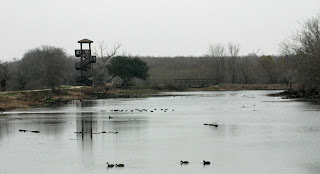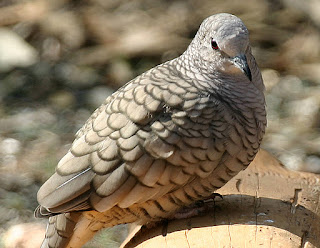Red-tailed Hawks and Northern Harriers are common raptors of the Texas Gulf Coast, pleasing both beginning and seasoned birders with their easy in-flight identification.
Red-tailed hawks are frequently spotted well overhead, soaring against blue sky. Birders will stop their ground-level hunting to look skyward, tilting heads and binoculars upward, tracking the famous circular soaring motion that reveals this hawk's beautiful red-fanned tail. This rather large buteo (19” long with a wingspan of 49”) appears especially “thick” in posture when sighted on a power line, with its red tail visible if viewing angle allows (and the birder is not in the driving position!). If you know of no other hawk by name or identification, the Red-tailed can easily become your first. Just watch the circular soaring motion of a large raptor against the sky, and when the angle of their flight tilts tail toward your ground view, catch that burst of color. If it is red, with no significant banding or striping, you’ve most surely identified a Red-tailed Hawk.
Contrasted to Red-tail Hawks' high sky soaring, Northern Harriers are commonly sighted flying low, over open brushy fields and marshes. This agile raptor shares the same Accipitridae Family as the Genus Buteo, but the Northern Harrier is the solo species in the Genus Circus. For the beginning birder, the Northern Harrier is easily identified in flight due to its rump (as you’d expect, the rump is the location on the bird where the top of the tail meets the bird’s lower back). In low flight, the harrier readily shows a white patch on its rump, followed by a dark tail. This white rump is quite obvious and gives beginning birders another easily identified raptor on their life list. Whether a pale gray raptor (male harrier) or overall brownish in color (female or juvenile harrier) it is the telltale white rump that cleanly identifies the Northern Harrier.
When I first began winter day trips to Galveston, I loved the drive to East Beach to watch the Black Skimmers and American Oystercatchers. Northern Harriers became a common sighting for me as low-flight hunters, with long bodies and smooth wing beats, coursing back and forth like an air-born lawn mower, some ten feet above the marsh grasses. These field and marsh hunters prey on small mammals and birds, and we can be thankful for their role in keeping rat and mice populations from exploding.
Most other raptors are harder to identify. Many have multi-year molts that continue to confound me. But another easily identified buteo, common to the Gulf Coast, is the Red-shouldered Hawk. A winter day’s drive will commonly find it perched on power lines of F.M. roads (especially FM 2004), but there is nothing like seeing this beautiful buteo in its natural hunting element. The Red-shouldered Hawk is a forest hunter. This beautiful bird of prey will sit silently perched on tree limbs, in what would seem an impossible bramble for it to maneuver, and quietly wait its hunt. Just as human hunters quietly hide behind a tree, or within a hunting blind, the Red-shouldered hunts in similar manner. This rather small buteo (17” long and a wing span of 40”) is often missed by human observers due to its secretive perching skills.
Frequently my sighting of a Red-shouldered is due to the noise and movement of its sudden chase and capture of a small mammal, reptile or amphibian in the forest habitat. With a wing span of 40” (think longer than a yard stick) I’m often amazed at its capacity to maneuver thickets and crooked limbs. And sometimes, it is the cry or squeal of the prey that draws my eye toward this stealthy hunter’s movement. I’ve watched these patient hunters capture squirrels in a full out chase within heavily limbed trees. As with other predators, a forest habitat is healthy when it can support these beautiful meat eaters.
When I first began winter day trips to Galveston, I loved the drive to East Beach to watch the Black Skimmers and American Oystercatchers. Northern Harriers became a common sighting for me as low-flight hunters, with long bodies and smooth wing beats, coursing back and forth like an air-born lawn mower, some ten feet above the marsh grasses. These field and marsh hunters prey on small mammals and birds, and we can be thankful for their role in keeping rat and mice populations from exploding.
Most other raptors are harder to identify. Many have multi-year molts that continue to confound me. But another easily identified buteo, common to the Gulf Coast, is the Red-shouldered Hawk. A winter day’s drive will commonly find it perched on power lines of F.M. roads (especially FM 2004), but there is nothing like seeing this beautiful buteo in its natural hunting element. The Red-shouldered Hawk is a forest hunter. This beautiful bird of prey will sit silently perched on tree limbs, in what would seem an impossible bramble for it to maneuver, and quietly wait its hunt. Just as human hunters quietly hide behind a tree, or within a hunting blind, the Red-shouldered hunts in similar manner. This rather small buteo (17” long and a wing span of 40”) is often missed by human observers due to its secretive perching skills.
Frequently my sighting of a Red-shouldered is due to the noise and movement of its sudden chase and capture of a small mammal, reptile or amphibian in the forest habitat. With a wing span of 40” (think longer than a yard stick) I’m often amazed at its capacity to maneuver thickets and crooked limbs. And sometimes, it is the cry or squeal of the prey that draws my eye toward this stealthy hunter’s movement. I’ve watched these patient hunters capture squirrels in a full out chase within heavily limbed trees. As with other predators, a forest habitat is healthy when it can support these beautiful meat eaters.
Although all raptors are mighty warrior hunters, I consider just about every one of them to be skittish to the point of being “chicken”. (A slur toward their genetic personality that I admit to mumbling on occasion, just as I’m raising camera lens to shoot them and they are flying in full retreat.) It is hard to get close to these mighty hunters, especially the Red-shouldered in its forest habitat. Human noise or movement on wooded path, and Red-shouldered Hawks are the first to take flight, leaving those brave and cheerful kinglets and chickadees to greet the birder. An opportunity to quietly study a Red-shouldered Hawk, in the forest setting, and at close range, is a day’s delight.
I got lucky Christmas Eve’s eve at Brazos Bend State Park. Alone and very quietly birding at an extremely slow pace, I came upon this beautiful Red-shouldered, perched rather openly on limb. We stared each other down for a delightfully long time. These three photos show its constant head movement, ever the ready hunter. And yes, it was my day’s delight.
































